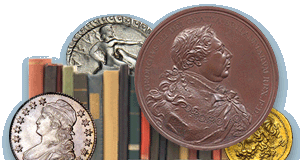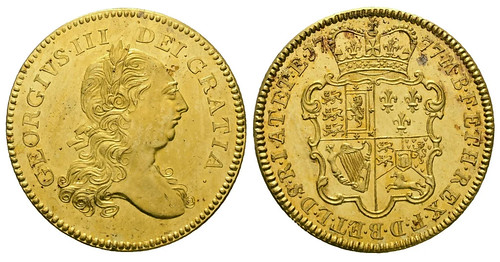
PREV ARTICLE
NEXT ARTICLE
FULL ISSUE
PREV FULL ISSUE
THE TRAVELLER COLLECTIONThis amazing story has already been making the rounds of the popular press. Here's the press release from Numismatica Ars Classica (NAC) about their upcoming sale of the Traveller Collection. -Editor The Traveller Collection: Historic coin collection, buried for 50 years, set for record-breaking auction
Numismatica Ars Classica is delighted to announce the sale of The Traveller Collection, a unique collection of coins with extraordinary provenance, which is coming to the market 85 years after the last coin was purchased. The Traveller Collection, comprising rare and highly sought-after pieces from around the world, will be auctioned over the next three years in what is believed to be the most significant ever sale of a single numismatic collection. The estimated insurance value of the collection exceeds $100 million, making this by far the most prized collection of coins to be sold at auction in the history of numismatics. Buried underground in aluminium boxes at the collector's property for over five decades, the coins had been carefully packed and stored in cigar boxes. The collection spans all geographical areas and contains exceptionally rare coins often in a state of preservation never seen in modern times. Several types have never been offered in a public auction, highlighting their considerable rarity. The collection was assembled in the 1930s and is made up of around 15,000 coins, including numerous examples which can be considered the finest specimen in private hands. The collector began to purchase gold coins after the Wall Street Crash in 1929, soon developing a taste for coins with great historical interest, beauty and rarity. No longer directly involved in the day-to-day running of his family business, the collector and his new wife spent the next decade travelling extensively across Europe, North and South America, acquiring rare and historically significant coins as they went and carefully documenting each purchase in a detailed archive. At the end of this extended honeymoon, the collector settled in a European location. When the threat of Nazi invasion became imminent, he chose to stay rather than flee the country, likely in part due to the difficulty of transporting his collection. Instead, the collector buried the coins on his property, but tragically died shortly after the Nazis invaded. The coins remained buried for over 50 years before finally being retrieved by his heirs and placed in a bank vault and later presented to Numismatica Ars Classica. Thanks to the meticulous records kept by the collector as well as the research by the team of experts assembled by NAC for this monumental cataloguing endeavour, many of the coins can be traced back to the auctions of some of the greatest collections of the late nineteenth and early twentieth centuries. Highlights from the collection include some of the rarest and most prized coins by numismatic collectors. Examples include:
The first auction in this remarkable series will feature the British machine-struck coins and medallions from the Traveller Collection, dating from Charles II all the way to a specimen set created for George VI in 1937. Another key example from this auction, one of the highlights of the entire Traveller collection, is a high grade Una and the Lion £5 by William Wyon, considered to be one of the most beautiful coins ever made. The £5 has an auction estimate of 250,000 CHF (GBP 218,921). Other highlights from this first auction will be announced in due course. Coins from the first auction will be on display at Numismatica Ars Classica's London office throughout April. Arturo Russo, Director of Numismatica Ars Classica, said: “We are incredibly proud to offer the extraordinary Traveller Collection at auction. The vast range and superb quality of the coins offered, the sheer number of great rarities and the fascinating story of the collection's formation will make these sales a landmark in the history of numismatics. The catalogues of the Traveller Collection will serve as an important reference for the future collectors and scholars." David Guest, director of David Guest Numismatics, and consultant to the collection, said: “When it came to cataloguing the British coins from the Traveller Collection I had to keep pinching myself to make sure I wasn't dreaming. Not only was the quality exceptional but many of the coins before me were of types not known to have been offered for sale in over 80 years and, in some cases, completely unrecorded” About Numismatica Ars Classica AG Founded in Zurich in 1988, Numismatica Ars Classica has gained a reputation as one of the world's leading and most trusted firms for ancient coins, primarily, but not limited to, Greek, Roman, Byzantine and Italian coins. Over the years NAC has sold some of the most important collections in the history of Numismatics and houses one of the largest and most varied selections of ancient coins in the world at their London branch in Mayfair. NAC currently holds two annual auctions for ancient coins, one in Spring and one in Autumn. The sales are always held at the exclusive Hotel Baur au Lac in Zurich. NAC has offices in London, Milan and Zurich. Website: www.arsclassicacoins.com
To read the CNN article, see:
Wayne Homren, Editor The Numismatic Bibliomania Society is a non-profit organization promoting numismatic literature. See our web site at coinbooks.org. To submit items for publication in The E-Sylum, write to the Editor at this address: whomren@gmail.com To subscribe go to: Subscribe All Rights Reserved. NBS Home Page Contact the NBS webmaster 
|



